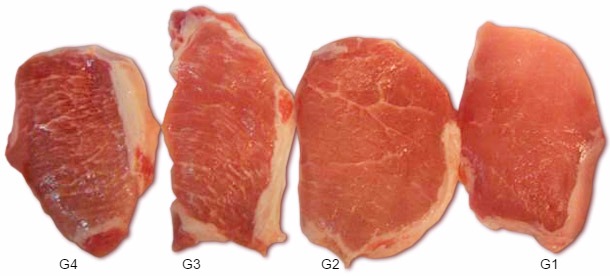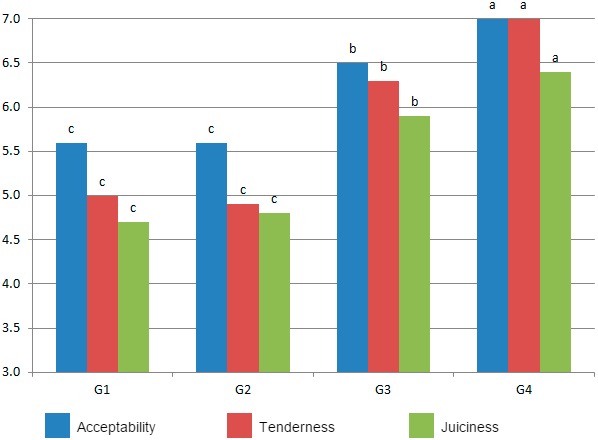Meat quality can be influenced by factors such as breed, sex , diet and ante-mortem management of the animals and post-mortem processing of the carcasses. Thus, meat from Duroc pigs, characterized by a high intramuscular fat content, is much appreciated for both fresh consumption and its use in the production of high quality cured hams.
Meat marbling is related to its flavour, juiciness and tenderness, and directly related to the intramuscular fat content. Meat with high levels of marbling is expected to have better sensory quality. However, consumers preferences differ, since there is now a clear tendency to consume more and more fat-free products and, as a result, the sensory quality of these products by consumers may be lower.

It follows that there is not a correspondence between visual sensory quality of the meat at the butchers or retailers and meat acceptability when it is consumed. Thus, in order to assess the effect of the intramuscular fat content on meat tenderness, juiciness and acceptability by consumers, a study was conducted where 4 loin pieces with different mean contents of intramuscular fat were tasted: G1: 0.96%, G2: 2.11%, G3: 3.72% and G4: 5.78%. A meat grading system ranging from 1 to 9 was used by consumers, where 1 was 'I do not like it', 'It is very firm' or 'It is very dry', and 9 'I like it a lot','It is very tender' or 'It is very juicy' (Photo 1).

Photo 1. Loin samples for visual assessment depending on their intramuscular fat content.
The study included 200 consumers between 18 and 73 years old, with about 50% men and 50% women. They first tasted the meat grilled and later, already outside the box where the meat was tasted, they were asked to do a visual grading of 4 samples of each intramuscular fat group, and to rank each slice according to their visual preference.

Figure 1. Acceptability, tenderness and juiciness scores (from 1 = "I do not like, very firm , very dry" to 9 = "I really like it, very tender, very juicy") depending on the intramuscular fat content group it belongs to (G1: 0.96%, G2: 2.11%, G3: 3.72% and G4: 5.78%). Bars for the same attribute with different superscripts indicate significant differences between groups (p>0.05).
The graph shows that, from the point of view of visual preference, Spanish consumers can be classified into two distinct groups: those who prefer very lean meat and those who like to see the marbling (since they probably know it has an impact on palatability and does not have negative health effects). However, when tasting the meat, both consumer groups gave higher scores to all the acceptability attributes of cooked meat containing a higher level of intramuscular fat. Therefore, the results show that the meat with the highest intramuscular fat content (marbling) had higher overall acceptability scores, as well as tenderness and juiciness scores. Thus, increasing intramuscular fat in meat can be a business strategy to obtain a more tasty meat, but we must bear in mind that some consumers prefer meat with no visual traces of intramuscular fat. Therefore, results show that purchasing decisions are complex because, even though some consumers prefer meat with no fat in sight, they prefer the meat with the highest marbling degree when they taste it. A minimum of intramuscular fat between 2.2% and 3.4% to enhance the meat acceptability was recommended.



